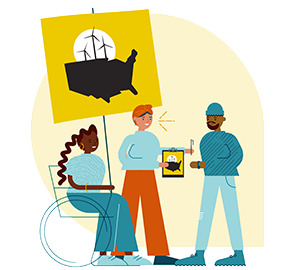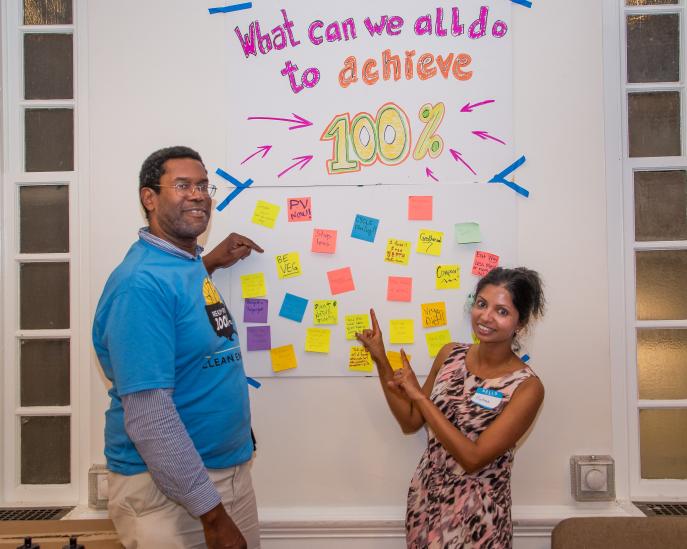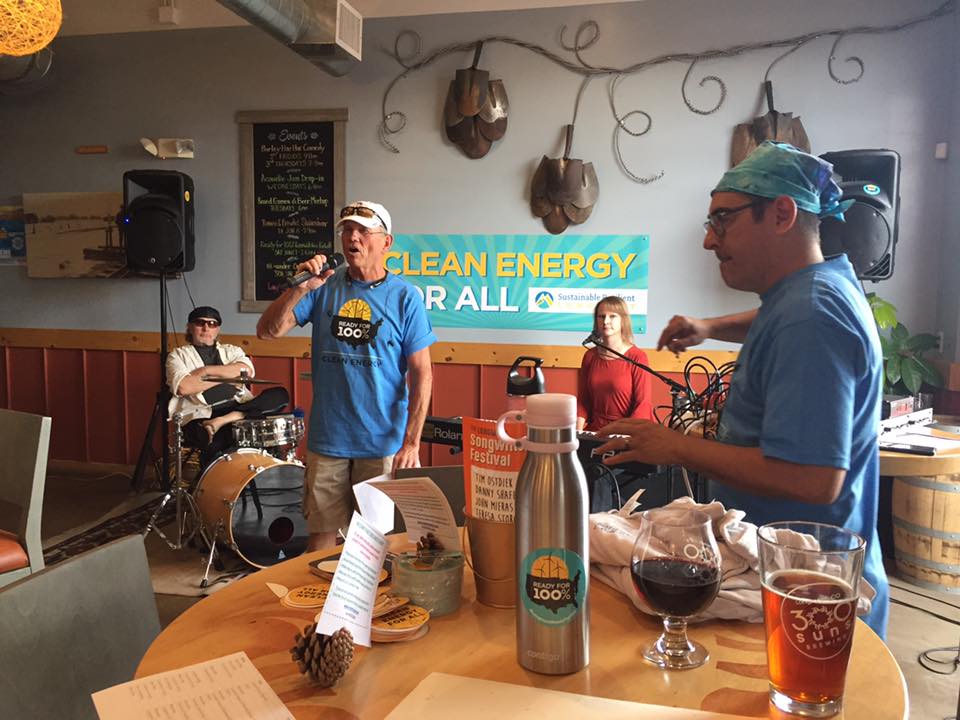Public Launch

-
Phase 3
- Plan Your Strategy
-
Phase 4
- Public Launch
-
Phase 5
- Organize!
-
Phase 6
- Implementation and Beyond
-
Contact Us
- Get help, give feedback, or share resources
Now that you have a team, a strategy, and a set of recommendations for a commitment in hand, your campaign is about to begin engaging with a much wider audience. Just as the time spent on building a campaign plan pays off in the long run, the time you spend preparing for your public launch is also worth the effort. Your campaign’s first burst of public attention must be carefully designed to tell your story, appeal to your target, garner media attention, and steer people to your campaign. You want the public — that's right, everyone — to know what you're trying to achieve and how to take action with you — whether that's in person or online.

Launch event with interactive visioning board in Philadelphia, PA. | Photo by E. Bryan Crenshaw III
Gather Your Supporters
Petitions
Petitions are a good tool for two reasons. For one, you can use the number of petition signatures to show the media the volume of support for your campaign; this visible volume of constituent support can also convince your decision makers to commit to 100% clean, renewable energy. You can deliver the names and comments of your petition supporters to your decision-makers all at once (via email or physical delivery) to make a big splash!
Secondly, they help you identify a person as a supporter of the campaign, providing you with their contact information so that you can follow up with them later! When you host an online petition as part of your AddUp campaign (more below), you can also collect supporters' personal messages, which are SUPER valuable and share their personal connection to the issue. You’ll want to have a petition ready before your public launch, even if it’s just to build a list of supporters you’ll ask to take more specific actions later on.
Types of Petitions
Online petitions Using an AddUp Campaign
Enlisting public support is a key Clean Energy For All goal — and AddUp can help you achieve it! AddUp allows you to set up an online homepage for your campaign where you can host a variety of online actions, including petitions, social media shares, and volunteer sign-ups. Having an online presence for your campaign is useful — and an AddUp.org campaign will serve as a central destination for the media, supporters, and decision makers to learn about your goals and campaign while also showing the volume of local support for a clean energy transition.
Having an AddUp campaign with a petition helps you sign up new supporters, get their contact information, and deliver a big list of supporters to local leaders asking them to transition your community to 100% clean, renewable energy. Additionally, AddUp enables you to build and manage events, sign up new supporters at those events, and communicate with all your campaign’s supporters with an update tool that emails your supporters automatically.
If you’ve already been given access to AddUp, you can head to the AddUp campaign management system to start building a campaign. Our AddUp help site offers step-by-step instructions on how to build an AddUp campaign from scratch. If you have not, please fill out this short form to get access.
AddUp Campaign Management Homepage
In order to create a campaign or action on AddUp, you need AddUp campaign management access.
If you have one, bring a laptop, tablet, or smartphone with you to events to have people sign the petition on AddUp, which will also save you from manual databasing later (see how in our AddUp Campaign Promotion & Communication FAQ). Additionally, AddUp lets you build five other actions — including events — as well as share updates and keep in touch with the people on the list so your supporters stay engaged.
Learn more about AddUp in the Online Actions & Events guide.
Paper Petitions
Even though your petition should be available online at your AddUp campaign, print paper petitions and always have them on hand for events in case there’s no wifi or cell service, or if using a device to record signatures becomes impractical. Ideally, when someone fills out a paper petition, someone from your team databases it within two days directly onto your AddUp page.
Keep your list of interested people active and engaged. The power of your base is the power that the list has to influence your decision maker. For some public leaders, there are a few key people or groups that they need to hear from to make the right decision; for others, they want to know that a lot of their constituents are behind the idea, so the size of the list is key. In either case, the list is only effective if the people on it are familiar with the campaign, updated regularly, have opportunities to show their support, and ultimately do show up!
It is up to us to ensure that we are giving people the opportunity to join the campaign, take action, and get more involved. You’ll probably want the people who are on your lists and sign your petition to show up to a bigger event later on, such as the petition-delivery event — and you can use AddUp’s campaign update tool to automatically email your supporters with news about your campaign and ways to take action (Unsure how? Check the AddUp Campaign Promotion & Communication FAQ). This process of getting interested people more involved is called the ladder of engagement (as mentioned in Phase 2). Keep building your momentum to bring folks up the ladder.
Kickoff Event

Clean Energy For All launch party at a local brewery in Longmont, CO. | Photo by Abby Driscoll.
Your first public event can take many forms — from showing a film to hosting a press conference. Whatever medium, the most important factor is to make it impactful. A well coordinated event that conveys a strong message will set the tone for your campaign and represent a key milestone in your campaign plan. Build your event in AddUp, add it to your AddUp campaign, and then share your campaign on social media and over email, get the word out through flyers, radio ads, community calendars, and group announcements. If you’re unsure how to do any of these actions in AddUp, check out our AddUp FAQ.
Make sure that you have a way to capture the information (names, phone numbers and emails) of the people who show up to your event. With any new person, schedule an individual meeting with them, commonly called the one-on-one. (Find full information about one-on-one meetings in Phase 2 of this toolkit.)
Scheduling two actions ahead for anything you plan is an effective way to keep building momentum in your campaign. For example, people come to the kickoff event, but you already have the next event on the calendar with flyers available. That way you can encourage the people who came to the public launch to be at the next event.
For extra attention, consider planning a pre-launch party to earn media coverage that can then direct people to get involved. Make sure to acknowledge and thank any people who have been working on issues of environmental and social justice in your community before you.
C3 or C4 Swag?
The materials mentioned in this section are compliant for the RF100 C3 campaign. The C4 campaign has its own brand, logo, colors and swag.
More About ComplianceUsing Online Organizing
These days, so much of our lives is moving online — so our organizing should, too. From strategy and planning to advocacy and recruitment to amplification and social media, online organizing should be woven throughout your entire campaign. By doing so, you will be able to reach new audiences, build relationships, engage and mobilize your community, and put pressure on your local leaders to join us in our vision for a just and equitable transition to 100% clean, renewable energy for all of our communities!
New tools and tricks for successful online organizing are always emerging as we move more and more online. But no matter what, there are certain key moments — such as directly before and after your kick-off event, or when you’re spreading the word about a recent campaign victory — when online organizing will always enable your efforts, pushing you toward your goals farther and faster. Head over to the Online Organizing Guide to learn more about how you can use digital strategy, tactics, and tools in your campaign.
Guide to Online Organizing
This guide includes sections on writing and sending mass emails, best practices for social media, and how to use our online campaign site.
Working with Traditional Media
Think back to your earlier research: what are the prevailing public narratives about clean energy in your community? Which voices carry those narratives?
Now, consider how your neighbors, friends, and people in your community, especially any local leaders or decision-makers, might hear about those stories. Where do they get the information to base their opinions on the issues? How do they get their news?
Those are the places you want your stories and messages to show up. Local newspapers, media outlets, and radio stations are high impact and have wide reach, making them great venues to shape the public narrative on your issues, build public support, and influence decision makers. Use the stories and messaging your team developed earlier to create a communications plan around gaining media coverage in these outlets. Head to this toolkit’s Communications Guide for resources on how to do that. When you start getting your story out there, be prepared — the opposition will certainly be ready to share theirs, too. This public dialogue is a battle over whose narrative and values will dominate. We win by ensuring our story resonates.
Communications Guide
This guide will help you plan your communication strategy and effectively get the word out to media, supporters and targets.
Frequently asked questions
False! The Sierra Club tool AddUp allows you to create petitions, get signatures and collect personal messages — plus your supporters’ contact information is saved directly online, so you don’t have to enter it later. Paper petitions have their use, but AddUp will make your task easier.
Both! Plan to launch your campaign and keep the public updated in traditional and digital media. You want to reach as large of an audience as possible. Learn more about how to spread the word in the Communications Guide.